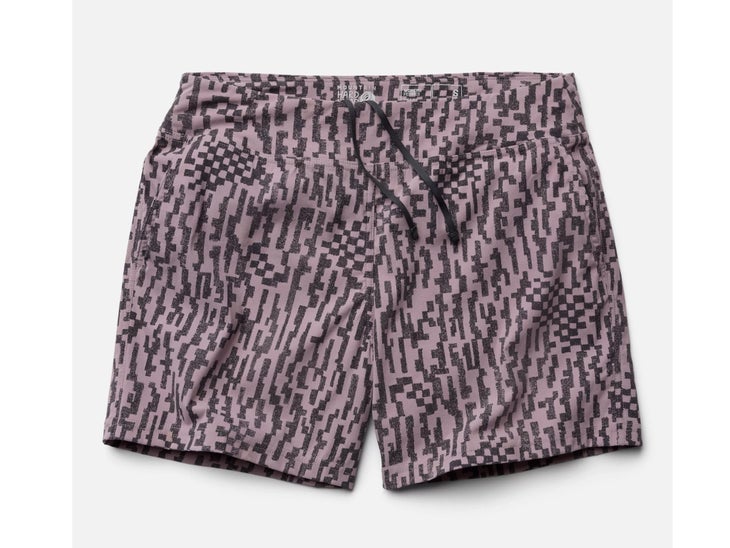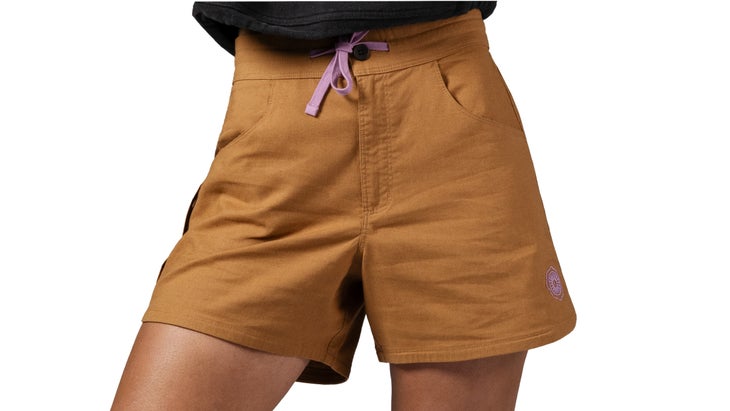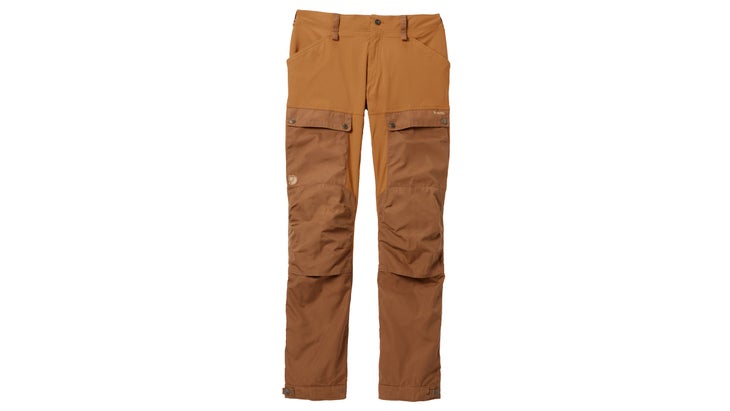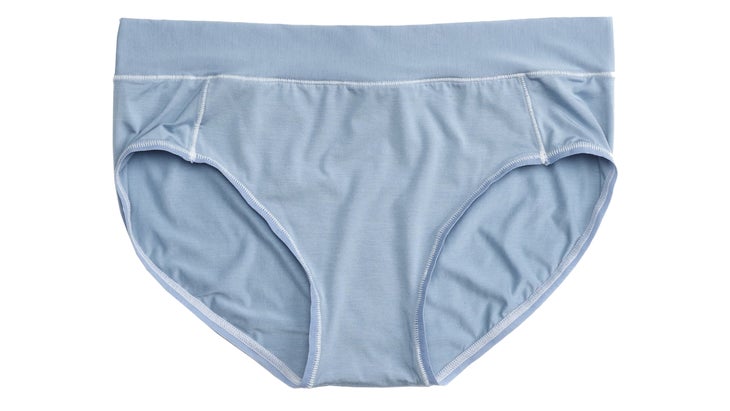Heading out the door? Read this article on the new Outside+ app available now on iOS devices for members! Download the app.
Diehard hikers often rank their bottoms—be they pants, shorts, skivvies, or skorts—as their single most important piece of performance apparel. That’s because they serve several functions, all of them critically important: They shield against chafing, manage sweat, and fend off assaults from trailside brush and branches. These layers for your lower half do all that—and more.
At a Glance
- Best Lightweight Short: Mountain Hardwear Women’s Dynama Short ($65)
- Best Multisport Short: Astral Kinisi Hemp Shorts ($79)
- Best Lightweight Pant: Black Diamond Alpine Light Pants ($130)
- Best Heavy-Duty Pant: Fjallraven Keb Trousers ($240)
- Best Underwear: Paradis Sport Natural Fiber Bikini ($32)
- Other Products We Tested
- How to Choose Hiking Pants
- How We Test
- Meet Our Testers

Best Lightweight Short
Mountain Hardwear Women’s Dynama Short
$65 at Backcountry $65 at Mountain Hardwear
Weight: 4.6 oz
Sizes: XXS-XL
Pros and Cons:
⊕ No chafing
⊕ Accommodates harness and pack hipbelt
⊗ Roomy waistband
Thanks to a great fit and stretchy fabric, the Dynama became a test favorite for hiking, climbing, SUPing, and every other sport where quick drying times and freedom of movement are valued above all else. The four-way stretch fabric (nylon with 6 percent elastane) dried quickly after a swim in Idaho’s Estelle Lake, boasts a UPF 50 rating, and has a fluorocarbon-free DWR that repelled unexpected splashes. Our Tahoe-area athlete appreciated the full, cling-free movement while climbing at Donner Summit, and the 3-inch inseam offered just enough coverage to prevent chafing. Two hand pockets hold a key fob, but cargo capacity is limited overall. The wide, flat waistband, which testers appreciated for its stretchiness and softness, runs big—but an internal drawcord cinches the excess.

Best Multisport Short
Astral Kinisi Hemp Shorts
Weight: 7 oz
Sizes: S-XL
Pros and Cons:
⊕ Very comfortable
⊕ Looks casual
⊗ Not water-repellant
We were surprised to find our favorite pair of everyday shorts from a brand specializing in paddle sports. But across the board, testers added the Kinisi to their daily uniform for camping, day hiking, paddling, and road tripping. “I adore the feel and breathability of this material,” raves our Minnesota tester, who abused the Kinisi while sliding across rough granite lakeshores and thwacking through tangled canoe portages. “These shorts show no signs of abrasion or pilling,” she reports. Credit the fabric’s hemp content (53 percent) for upping durability and mopping sweat. The loose-fitting cut and a smidge of spandex feels unconfining, even while squatting to filter water. And thanks to two generously-sized hand pockets, you don’t have to worry about losing your smartphone in a stream. Two additional zippered rear pockets are large enough to secure a credit card. Our only complaints? While the fabric dried fast in hot and dry conditions, it isn’t ideal for extended rain, especially when the mercury drops. Hemp, like cotton, has a chilling effect when wet, and it lacks the slickness of polyester: One tester experienced chafing during a humid 12-mile hike.

Best Lightweight Pant
Black Diamond Alpine Light Pants
$130 at Backcountry $149 at Black Diamond
Weight: 8.8 oz
Sizes: XXS-XXL
Pros and Cons:
⊕ Stretchy
⊕ Comfy waistband
⊗ Trim fit
Hiking and scrambling in these ultra-stretchy pants feels like wearing nothing at all—that’s how unconfining they proved to be while testers high-stepped up rugged rock ledges in central Maine.
That stretch comes from the Alpine Light’s Bluesign-approved, four-way stretch nylon (with 15 percent elastane). The fabric buffers rain thanks to a PFC-free DWR finish and does a decent job taking the edge off wind, too. Even granite couldn’t pierce this fabric, as our tester discovered during an unintended butt-slide on Maine’s Pleasant Mountain. Breathability is adequate, though in the hottest, most humid conditions, testers wished for more airflow between their skin and fabric (the fit is clingy). And while not all wearers adored the body-hugging cut, most felt that the pants transition to city life better than baggier tech pants.
The soft, stay-put waistband earned rave reviews, and our 5’10” tester appreciated the long leg length: “I usually find hiking pants a little short, but these provide perfect coverage over the ankles,” she reports. Our only complaint? In addition to the two open-topped pockets in front and one in back, testers wished the zippered thigh pocket was deeper to fit a smartphone.

Best Heavy-Duty Pants
Fjällräven Keb Trousers
$240 at REI $240 at Backcountry
Weight: 1 lb 5 oz
Sizes: 2-18, 3 lengths
Pros and Cons:
⊕ Durable
⊕ Sustainable construction
⊗ Heavy
⊗ Expensive
When you’re headed off-trail, a standard pair of breezy joggers just won’t cut it. Our favorite pant for when the going gets tough is Fjällräven’s Keb. The stiff, thick fabric is built for battle with scrub and spikes: The main fabric combines nylon with 26 percent polyester and 11 percent spandex for stretch, but most of the legs and seat are reinforced with burly panels of recycled polyester and organic cotton (35 percent). “I put these pants through the meat grinder doing trail maintenance in rough and rugged areas of the Great Lakes, but they came out unscathed, save for a little staining from pine tar,” reports our Minnesota-based tester. “I’ve never used a pair of trailwork pants that I would ever consider backpacking in, but these are it.”
Beyond durability, there’s a lot to love. Stretch allows for unfettered movement, a natural wax coating beads light rain, and mesh-backed venting zips on the thighs provide airflow. The Kebs fit long, slim legs best—although there’s a version for curvier bodies—and ultralighters won’t brook the weight penalty: At 20 ounces, these pants are neither light nor packable.

Best Underpants
Paradis Sport Natural Fiber Bikini
Weight: 1 oz.
Sizes: S-XL
Pros and Cons:
⊕ Limits clamminess
⊕ Sustainable
⊕ Stays in place
⊗ Expensive
Once testers tried these plant-based briefs (made of superfine rayon derived from tree pulp) they refused to go back to plasticky synthetic standards. “I love the soft fabric, breathability, and odor control throughout sweaty activity,” said one New Hampshire-based tester. Moisture management ranks among the best we’ve tested: In hot, high-humidity forests, the fabric wicked sweat and dried fast. The Natural Fiber Bikini has been through several seasons of daily wear without any sign of snagging or seam trouble. The broad waistband never pinches, the flat seams don’t chafe, and the patterning ensures that these bottoms stay in place through wearers’ every stride.
Other Products We Tested
Patagonia Quandary Pants ($99): This runner-up for the title of “Best Lightweight Pants” is lightweight, durable, and not oppressive in hot weather, but the close fit and relative lack of stretch (4 percent spandex with recycled nylon) compromises day-long comfort.
Skida Lightweight Viska Pant ($78): Wildly stretchy and exceptionally light, this high-waisted pant became testers’ go-to for everything from trail hiking to music festival booty-shaking, but the soft fabric (polyester with 10 percent spandex) is too fragile for rugged applications (such as rock scrambling and off-trail bushwhacking).
Outdoor Research Ferrosi Skort ($79): Not every hiker opts to rock a skort, but those that do swooned over this sweat-wicking combination of stretchy undershort (its 5-inch inseam doesn’t creep up while hiking) and abrasion-resistant nylon shell (48 percent recycled, with 14 percent spandex).
How to Choose Hiking Pants
Fit is paramount. Apparel that doesn’t suit your shape can prove uncomfortable on the trail. It’s also likely to languish in your closet because you won’t feel excited about wearing it. Once you’ve found apparel that fits, consider its fabric content: Different fibers deliver various performance benefits and drawbacks:
- Nylon resists abrasion and dries fast, but can feel rough against the skin.
- Polyester is softer to the touch, but sometimes less durable. Unless treated with an odor-resistant finish, it also gets stinky after contact with body sweat and bacteria.
- Elastane (sometimes branded as Spandex) provides stretch but slows the fabric’s dry time.
- Merino wool is breathable, temperature-regulating (it cools you in warm weather and insulates you in chilly conditions) and naturally odor-resistant, but can be less durable than synthetics.
Finally, consider how garment features may dovetail with the rest of your hiking kit. Will the pull tabs on zippered hip pockets create hot spots beneath a pack’s hip belt? Do the pant cuffs pick up dirt and mud while wearing low-top hikers? By forecasting how your apparel will integrate into your ensemble, you can avoid buying pieces that might disappoint you while hiking.
How We Test
- Number of Testers: 8
- Number of Products Tested: 61
- Number of Miles Hiked: 267
- Loftiest Summit Tagged: 14,429 feet
- Most Continuous Steps Climbed: 2,744 (Manitou Incline)
- Pounds of Porcini Foraged: 21
All hikers are wonderfully unique, which is why we tapped a group of testers with the most diverse body types and hiking habits we could wrangle. One tester who serves on Search and Rescue and rarely registers fatigue before mile 80 struggles to find pants that accommodate her extra-capable calves. Another tester loves short-shorts but hates inner-thigh chafing. Short legs, broad bellies, sensitive skin—these and other realities helped us evaluate and winnow out the products that don’t fit and feel comfortable on an array of women’s bodies.
Our diverse group of testers put these bottoms through their paces all across the United States and Canada, from Maine’s deep forests to the gusty summits of the Colorado Rockies.
Meet Our Testers
Over the 20 years that Kelly Bastone has been subjecting her 4’11” frame to the gear-testing mission, she’s watched the outdoor industry make significant improvements to the fit and function of women’s apparel. Yet even now, pants rarely earn her approval (properly fitting her pear shape requires an above-average attempt at patterning). Living in Maine puts a wealth of testing opportunities at her doorstep—she hikes, mountain bikes and fly-fishes from the Atlantic to the Appalachians.
For her testing squad, she recruited Lake Tahoe area trekker and climber Jessica Hamilton, Colorado River hiker and rafter Sabrina Motta, Minnesota trail worker and paddler Kate Ratkovich, and a range of additional women representing various outdoor experiences and body types.
